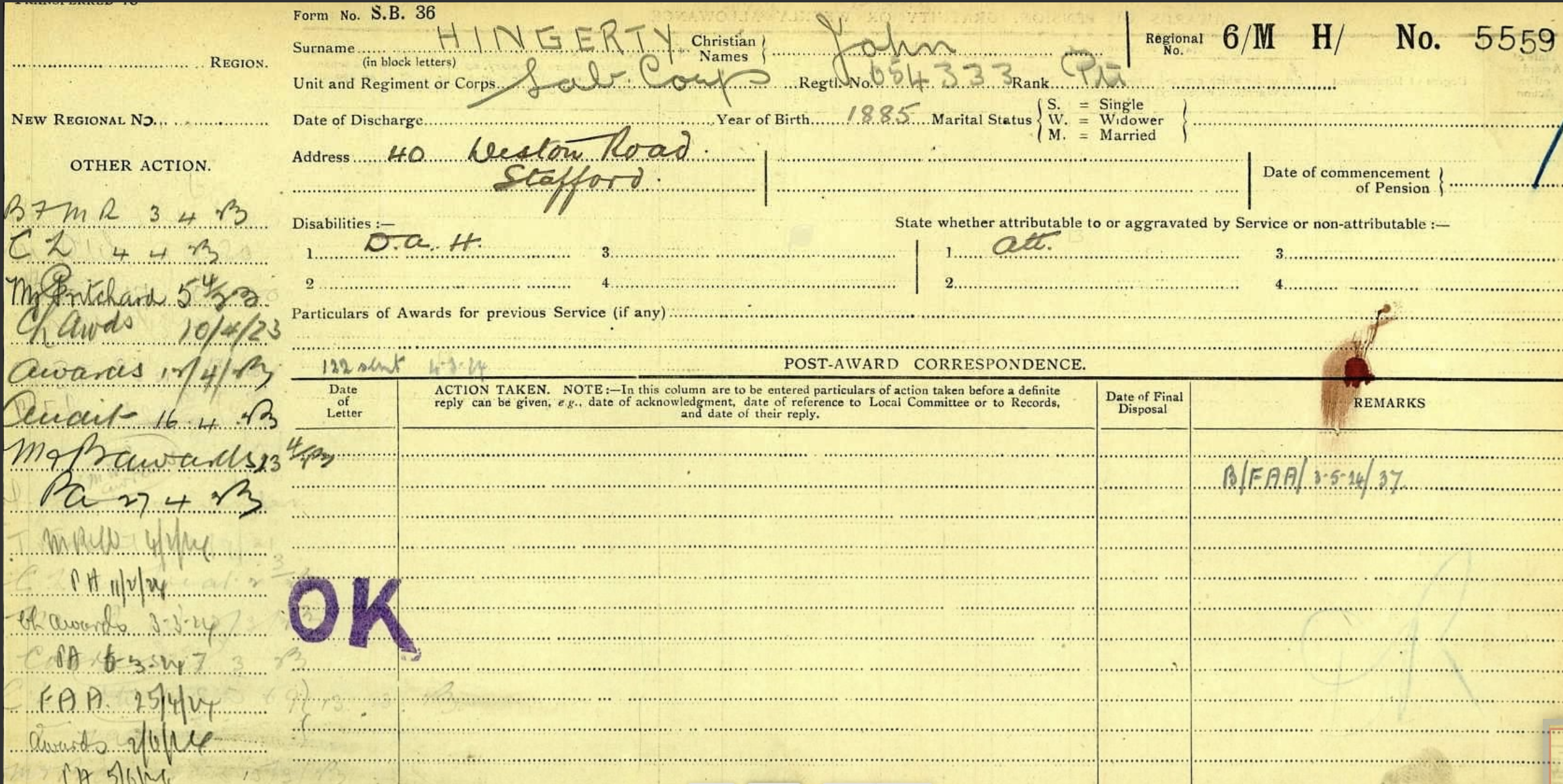John Hingerty (1885-1940)- Military Service
John Hingerty (1885-1940)
North Staffordshire Regiment
45573
Labour Corps
654333
The Derby Scheme
What was the Derby Scheme?- it was a process of recruitment instituted by the UK government in 1915 using locals to pressure able bodied men (married and single) in their neighbourhood into enlisting. The scheme was needed due to the enormous losses being suffered in the early stages of the war. It was later replaced with Conscription in 1916.
For further information see The Derby Scheme
The British Army Ancestors researcher postulates that John probably originally attested (was voluntarily added to a list of those willing to serve) under the Derby Scheme in December 1915, but was not called to active service until mid 1917.
Regimental Serial Numbers
There are no documents relating directly to John Hingerty found to date to provide direct evidence for the likely scenario outlined in the Facebook post.
However, the British Army Ancestors researcher outlines in his full report that he compared John's number of 45773 with the records for other men with numbers before and after in the sequence.
As numbers were issued sequentially this comparison is an excellent way to use indirect evidence to draw a very likely conclusion.
The researcher found that men with the serial numbers 45545, 45561, 45563, 45569 and 45587 all mobilised with the North Staffordshire Regiment on June 4, 1917. Serial number 45570 mobilised with the North Stafford regiment on 2nd June 1917.
Three of these men had attested in December 1915.
So it would seem likely that John mobilised on or around 4 June 1917 and may well have attested as part of the Derby Scheme in December 1915.
Cap Badge
The cap badge worn by John in his picture, probably taken at the beginning of his military service, seems to be that of the North Staffordshire Regiment rather than the Labour Corps, adding further indirect evidence that he began his military service with that regiment.
 |
| Cap Badge North Staffordshire Regiment |
 |
| Cap Badge British Labour Corps |
Medals
Victory Medal
For further information see Victory Medal Wikipedia
British War Medal
Qualifications: Officers and men of the British Army, including Dominion and Colonial forces, were required to have either entered an active theatre of war or to have left the United Kingdom for service overseas between 5 August 1914 and 11 November 1918, and to have completed 28 days mobilised service.
For further information see British War Medal- Wikipedia
Having qualified and been awarded these two medals we know that John saw active duty in a theatre of war during WW1.
Regiments
History of North Staffordshire Regiment
History of Labour Corps
A Pension Card of 1919 clearly indicates that John was in the LC i.e Labour Corps, and the 3rd Battalion of the North Staffordshire Regiment.
As a member of the 4th Battalion, John would have been involved in a number of difficult, hard fought battles.
From his Labour Corps service number of 645333, the British Army Ancestors researcher postulates that John would have transferred to the Labour Corps on 25th October 1918 and would have served with the 334 PoW Company in France supervising PoW working parties. (Unfortunately the war diaries for the 334 PoW Company do not exist.)
Numbers 654334, 654337, 654339 and 654347 were all 'Compulsorily and permanently transferred' to 334 PoW Company on that date.
John could have been transferred to the Labour Corps after medical treatment as this was often the practice at the time.
There are no medical records confirming either his injuries (heart fatigue or wounds from shrapnel?) or treatment (in France or back in the UK?)
WW1 officially ended on 11th November 1918, so John's service with the Labour Corps would have only been for a short time before he was demobilised.
Pension
The only other document found to date relating to John Hingerty's military career, lists a grant of 60 pounds for 'Tobacco.Confectionery". This seems a great deal of funding for the purpose?
The grant appears to have been made on 15th March 1923, however the date stamp indicates 22 April 1932???? Was the grant issued on two separate occasions?
Other Family Members
John died on 22nd June 1940 at the age of 55.
Summary
John Hingerty served his country in WW1 in the North Staffordshire Regiment and the Labour Corps.
Evidence, direct and indirect, suggests that he Attested in December 2015, served with the 3rd Battalion of the North Staffordshire Regiment from June 1917, which later became the 4th Battalion, serving on the Western Front from October 1917 and the PoW Company of the Labour Corps from October 1918.
His pension record shows that he suffered heart trouble as a direct result of his wartime labours. Family oral history says that he was 'blown up' and carried by a fellow soldier to medical assistance.
It would be very helpful if his Attestation record could be found as this would list details of his date of enlistment, service and medical history and physical description. This record may lie within the records of the National Archives or the record may no longer exist. It is however worth pursuing due to the significance of the information it may contain.
How to apply for military records
If you have any further information about John's military career, please make contact
Make a Comment or
Send an Email
hingerty@one-name.org






















Comments
Post a Comment